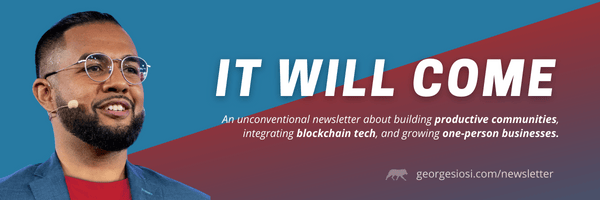- Micro Empires
- Posts
- O le Tulāfale ("the Orator")
O le Tulāfale ("the Orator")
Daily #093

Happy Tuesday!
So yesterday I talked about Rhetoric & Civil Discourse. Today, as promised, I'm going to talk about O le Tulāfale ("the Orator").
This may give you some insights into the way different cultures treat the role of "storytelling," which is essentially what most great speakers and writers are good at.
If you look into the greatest brands of today - from Bored Apes in the NFT space, to Nike and Apple - they all have a knack for telling powerful stories. And it is these stories that fuel the growth of communities and plant the seeds for culture long-term.
What is O le Tulāfale?'

O le Tulāfale stands for "the Orator" in Sāmoan.
Sidenote: most people don't know this, but the correct way to say 'Samoa' is with a long 'aah' sound on the first 'a' in Samoa. Hence why the ā is used to indicate the longer sound. So 'saah-mo-ah' instead of 'sa-moe-uh'.
For those unfamiliar, Sāmoan is the language of Sāmoa, a small island nation in the South Pacific consisting of two main islands and several, smaller uninhabited ones (pictured above).
Sāmoa is part of my ancestry from my mother's side.
What is the significance of an Orator?
Just like some ancient cultures revered professional storytellers (see The Last Storytellers: Tales from the Heart of Morocco), in Sāmoa, they revered the Orator.
The reason orators held such high standing is because of their inclusion under fa'amatai, the indigenous political ('chiefly') system central to Sāmoan culture.
The Orator is also known as the "talking chief," which formed under a hereditary class termed Tulāfale. The culture surrounding chiefly oratory is highly developed, with its own style and language.¹
This is because, before the arrival of European missionaries, knowledge was passed down primarily through oral traditions.
Therefore, these systems needed to be incredibly precise in order to ensure the right information was passed down from generation to generation - a far cry from the way we treat language and knowledge today (just look at social media).
What makes O Le Tulafale's rhetoric different?
In Sāmoa, heads of extended families are typically titled chiefs (or matai).
Their positions are selected on basis of intelligence, industry, and wisdom (imagine if we chose leaders based on their wisdom vs. popularity?).
There are a lot of responsibilities that come with the matai title, including administering family lands, upholding group prestige and honor, and supervising familial work and ceremonial activities.²
In relation to yesterday's newsletter on Rhetoric & Civil Discourse, the Tulafale (Orator) uses a specialized form of rhetoric to tell the histories of the people, give political and religious insights, and inform the village of important news.
It is often delivered in a clear and ringing cadence, often yelled out.
Tomorrow, we'll talk about how Sāmoa's formal oral traditions are intricately tied to their sense of the "sacred," and why that matters when engaging in speech or dialogue.
Until tomorrow, remember: it will come.
Subscribe to Premium Membership to read the rest.
Become a paying subscriber of Premium Membership to get access to this post and other subscriber-only content.
Already a paying subscriber? Sign In

